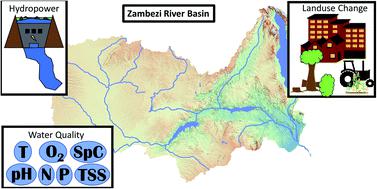当前位置:
X-MOL 学术
›
Environ. Sci.: Processes Impacts
›
论文详情
Our official English website, www.x-mol.net, welcomes your
feedback! (Note: you will need to create a separate account there.)
Anthropogenic influences on Zambian water quality: hydropower and land-use change
Environmental Science: Processes & Impacts ( IF 4.3 ) Pub Date : 2021-5-27 , DOI: 10.1039/d1em00006c R Scott Winton 1 , Cristian R Teodoru 2 , Elisa Calamita 1 , Fritz Kleinschroth 3 , Kawawa Banda 4 , Imasiku Nyambe 4 , Bernhard Wehrli 1
Environmental Science: Processes & Impacts ( IF 4.3 ) Pub Date : 2021-5-27 , DOI: 10.1039/d1em00006c R Scott Winton 1 , Cristian R Teodoru 2 , Elisa Calamita 1 , Fritz Kleinschroth 3 , Kawawa Banda 4 , Imasiku Nyambe 4 , Bernhard Wehrli 1
Affiliation

|
The Zambezi River Basin in Southern Africa is undergoing rapid development and population growth. Agricultural intensification, urbanization and future development of hydropower dams will likely lead to a degradation of surface water quality, but there have been few formal assessments of where, how and why these changes impact specific water quality parameters based on in situ data spanning a large region. We sampled a large suite of biogeochemical water quality parameters at 14 locations in four field campaigns in central and southern Zambia in 2018 and 2019 to characterize seasonal changes in water quality in response to large hydropower dams and human landscape transformations. We find that the major rivers (Zambezi and Kafue) are very clean with extremely low concentrations of solutes, but suffer from thermal changes, hypoxia and loss of suspended sediment below dams. Smaller tributaries with a relatively large anthropogenic landcover footprint in their catchments show signs of pollution in the form of higher concentrations of nutrients and dissolved ions. We find significant relationships between crop and urban land cover metrics and selected water quality metrics (i.e. conductivity, phosphorus and nitrogen) across our data set. These results reflect a very high-quality waterscape exhibiting some hotspots of degradation associated with specific human activities. We anticipate that as agricultural intensification, urbanization and future hydropower development continue to accelerate in the basin, the number and extent of these hotspots of water quality degradation will grow in response. There is an opportunity for governments, managers and industry to mitigate water quality degradation via investment in sustainable infrastructure and practice, such as wastewater treatment, environmental dam operations, or riparian protection zones.
中文翻译:

人为因素对赞比亚水质的影响:水电和土地利用变化
南部非洲的赞比西河流域正在经历快速发展和人口增长。农业集约化,城市化和水电大坝的未来发展可能会导致地表水水质下降,但是很少有关于这些变化在何处,如何以及为什么影响就地水质参数的正式评估。跨大区域的数据。我们在2018年和2019年在赞比亚中部和南部的四个野外活动中,在14个地点对一大套生物地球化学水质参数进行了采样,以表征响应大型水电大坝和人类景观变化而引起的水质季节性变化。我们发现主要河流(赞比西河和卡富河)非常干净,溶质浓度极低,但遭受热力变化,缺氧和大坝下方悬浮沉积物流失的困扰。较小的支流在其流域具有较大的人为土地覆盖面积,但由于养分和溶解离子的浓度较高,因此显示出污染迹象。我们发现作物和城市土地覆盖率指标与选定的水质指标(即电导率,磷和氮)。这些结果反映出非常高质量的水景,表现出某些与特定人类活动相关的退化热点。我们预计,随着流域内农业集约化,城市化和未来水电的发展继续加快,这些水质退化热点地区的数量和范围将随之增加。政府,管理人员和工业界有机会通过投资于可持续基础设施和实践(例如废水处理,环境大坝运营或河岸保护区)来减轻水质恶化的机会。
更新日期:2021-05-27
中文翻译:

人为因素对赞比亚水质的影响:水电和土地利用变化
南部非洲的赞比西河流域正在经历快速发展和人口增长。农业集约化,城市化和水电大坝的未来发展可能会导致地表水水质下降,但是很少有关于这些变化在何处,如何以及为什么影响就地水质参数的正式评估。跨大区域的数据。我们在2018年和2019年在赞比亚中部和南部的四个野外活动中,在14个地点对一大套生物地球化学水质参数进行了采样,以表征响应大型水电大坝和人类景观变化而引起的水质季节性变化。我们发现主要河流(赞比西河和卡富河)非常干净,溶质浓度极低,但遭受热力变化,缺氧和大坝下方悬浮沉积物流失的困扰。较小的支流在其流域具有较大的人为土地覆盖面积,但由于养分和溶解离子的浓度较高,因此显示出污染迹象。我们发现作物和城市土地覆盖率指标与选定的水质指标(即电导率,磷和氮)。这些结果反映出非常高质量的水景,表现出某些与特定人类活动相关的退化热点。我们预计,随着流域内农业集约化,城市化和未来水电的发展继续加快,这些水质退化热点地区的数量和范围将随之增加。政府,管理人员和工业界有机会通过投资于可持续基础设施和实践(例如废水处理,环境大坝运营或河岸保护区)来减轻水质恶化的机会。











































 京公网安备 11010802027423号
京公网安备 11010802027423号